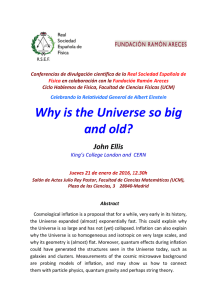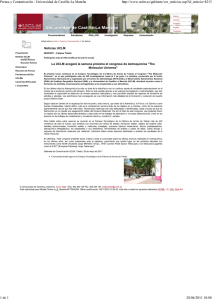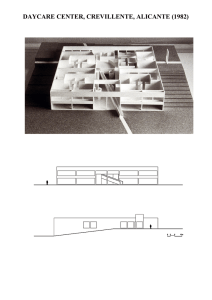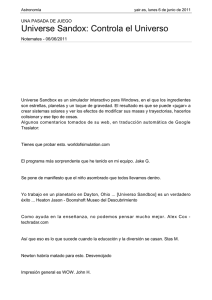THE MOLECULAR UNIVERSE ENTREVISTA CON JOHN BLACK
Anuncio
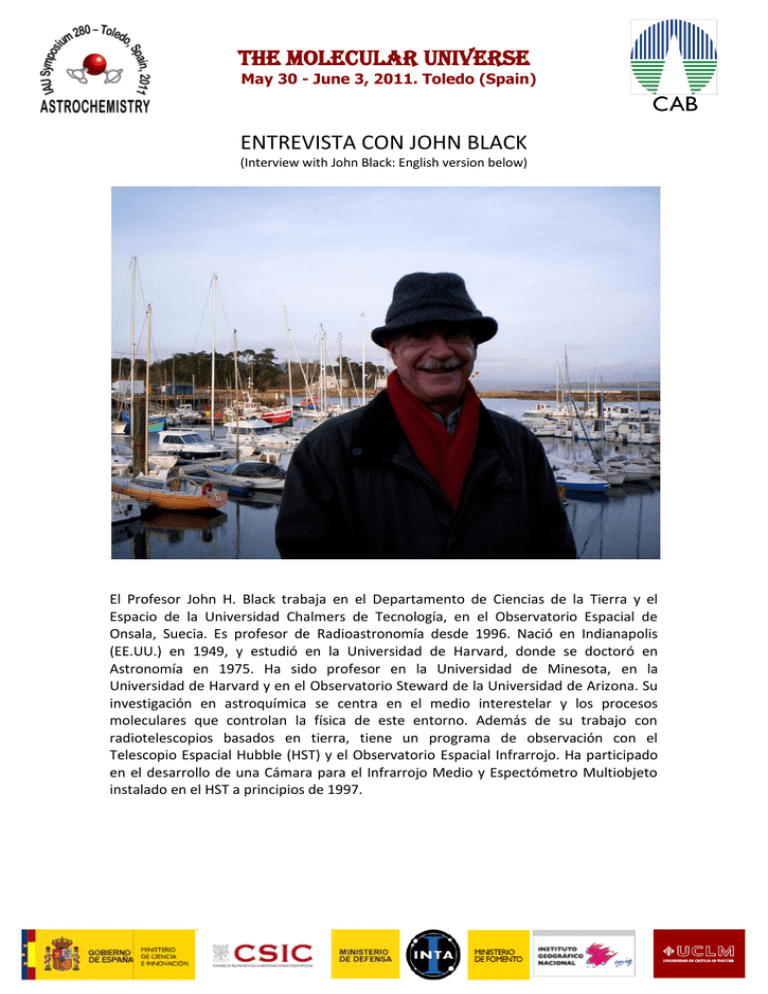
THE MOLECULAR UNIVERSE May 30 - June 3, 2011. Toledo (Spain) ENTREVISTA CON JOHN BLACK (Interview with John Black: English version below) El Profesor John H. Black trabaja en el Departamento de Ciencias de la Tierra y el Espacio de la Universidad Chalmers de Tecnología, en el Observatorio Espacial de Onsala, Suecia. Es profesor de Radioastronomía desde 1996. Nació en Indianapolis (EE.UU.) en 1949, y estudió en la Universidad de Harvard, donde se doctoró en Astronomía en 1975. Ha sido profesor en la Universidad de Minesota, en la Universidad de Harvard y en el Observatorio Steward de la Universidad de Arizona. Su investigación en astroquímica se centra en el medio interestelar y los procesos moleculares que controlan la física de este entorno. Además de su trabajo con radiotelescopios basados en tierra, tiene un programa de observación con el Telescopio Espacial Hubble (HST) y el Observatorio Espacial Infrarrojo. Ha participado en el desarrollo de una Cámara para el Infrarrojo Medio y Espectómetro Multiobjeto instalado en el HST a principios de 1997. THE MOLECULAR UNIVERSE (IAU SYMPOSIUM 280) May 30 - June 3, 2011 (Toledo (Spain) Profesor Black, ¿en qué campo desarrolla su investigación? Me interesan casi todos los fenómenos astronómicos, empezando por las atmósferas del sol, los planetas y los cometas, pasando por los misterios de las nubes de gas interestelar, hasta las galaxias observables más distantes del universo. Los procesos atómicos y moleculares y la espectroscopía son los aspectos en común de todos estos temas de interés. Es fascinante que cosas tan diferentes puedan tener tanto en común a un nivel microscópico. Actualmente, estoy más interesado en el uso de moléculas como sensores remotos de rayos X y de partículas energéticas llamadas rayos cósmicos. Espero que esto nos lleve a un mejor entendimiento de cómo galaxias enteras, formadas por gas y estrellas, evolucionan a través del tiempo cósmico. ¿Cuáles cree que son los avances más importantes de su campo en los últimos años? Algunos de los avances más importantes implican grandes colaboraciones internacionales en misiones espaciales y grandes telescopios. Particularmente, me refiero a los sondeos de la Cassini-Huygens para explorar Saturno, sus anillos y sus satélites; el Telescopio Espacial Herschel, que ha abierto una de las últimas fronteras del espectro electromagnético a las observaciones en longitudes de onda del infrarrojo lejano y ondas submilimétricas; y el radiotelescopio más poderoso de la Tierra, el Atacama Large Millimeter-submillimeter Array (ALMA), que va a entrar en operación próximamente en Chile. También se han llevado a cabo experimentos de laboratorio excelentes en ciencia de superficie para simular las condiciones en los hielos que crecen en las partículas de polvo interestelar a temperaturas de 10 grados bajo cero absoluto. El descubrimiento de iones negativos en el espacio se nos ha presentado como un puzle inesperado. ¡Y hay muchos más ejemplos! ¿Cuál es la importancia de un congreso de este tipo desde un enfoque internacional? Este es el último de una serie de simposios de Astroquímica patrocinados por la Unión Astronómica Internacional (International Astronomical Union, IAU). Estos encuentros han jugado un papel determinante a la hora de hacer de la astroquímica un área de investigación interdisciplinar. Este congreso llega en un momento sumamente interesante, cuando los resultados de las nuevas observaciones hechas con misiones espaciales han alcanzado a los innovadores experimentos de laboratorio y a los avances teóricos. La Unión Astronómica Internacional ha apoyado firmemente nuestro esfuerzo para unir a astrónomos de todo el mundo. ¿Qué opina sobre la evolución de la Astroquímica en España y sobre su desarrollo futuro? Los investigadores españoles han estado en la vanguardia de la investigación astroquímica. Es importante reconocer que nuestra investigación en astroquímica, impulsada por la curiosidad, tiene conexiones significativas con el mundo práctico que nos rodea. El deseo de comprender la química y la física de los planetas alrededor de THE MOLECULAR UNIVERSE (IAU SYMPOSIUM 280) May 30 - June 3, 2011 (Toledo (Spain) otras estrellas también nos habla de la urgente necesidad de comprender mejor cómo funciona el sistema físico-químico de nuestro propio planeta. Recientes desarrollos en procesamiento de señal, manejo de bases de datos, y transmisiones de alta velocidad de enormes cantidades de datos en Astronomía forman parte de una actividad más amplia en el trabajo en red y tecnología de la información. ¿Qué espera descubrir su comunidad científica en la próxima década? Seguramente descubriremos que la química cósmica es mucho más interesante y sorprendente de lo que creíamos. Seremos capaces de hacer análisis químicos de las atmósferas de algunos planetas que orbitan otras estrellas y de observar acontecimientos en el inicio del nacimiento de nuevos planetas. A la reciente identificación de moléculas muy grandes como la C60 y la C70 en el espacio, le seguirá el descubrimiento de moléculas prebióticas aún mayores. Sin embargo, en lugar de simplificarlos, estos descubrimientos probablemente complicarán nuestros intentos por comprender el origen de la vida. Vídeos: Canal Youtube del Simposio con entrevistas: http://www.youtube.com/user/IAUsymposium280 Más información: Página web del Simposio: http://cab.inta-csic.es/molecular_universe/ Retransmisión en directo: http://www.cienciatk.csic.es/ Otros enlaces de interés: http://www.chalmers.se/en/research/professors/Pages/descriptions/john-h-blackradio-astronomy.aspx THE MOLECULAR UNIVERSE (IAU SYMPOSIUM 280) May 30 - June 3, 2011 (Toledo (Spain) Interview with John Black John H. Black is Professor at the Department of Earth & Space Sciences of the Chalmers University of Technology, in the Onsala Space Observatory (Sweden). John H Black was appointed Professor of Radio Astronomy on January 10, 1996. He was born in 1949 in Indianapolis, USA. He studied at Harvard University and took his PhD in 1975 in Astronomy. He has been assistant professor at the University of Minnesota and research associate and university lecturer at Harvard University, as well as assistant professor and Astronomy professor at the Steward Observatory, University of Arizona. John Black's research in astrochemistry is focused mainly on the interstellar medium and the molecular processes that control its physics. In addition to his work with landbased radio telescopes he has an observation programme at the Hubble Space Telescope (HST) and at the Infrared Space Observatory. He has participated in the development of a Near-Infrared Camera and Multi-Object Spectrometer which was installed at HST at the beginning of 1997. In what field do you develop your research? I am interested in almost all astronomical phenomena, beginning with the atmospheres of the sun, planets, and comets, through the mysteries of interstellar gas clouds, to the most distant observable galaxies in the universe. Atomic and molecular processes and spectroscopy are the common threads running through all these interests. It is fascinating to me that such different things can have so much in common at the microscopic level. At present, I am most interested in using molecules as remote sensors of X-rays and energetic particles called cosmic rays. I hope that this will lead to a better understanding of how whole galaxies of stars and gas evolve over cosmic time. Which ones do you consider are the most important advances done in the last years in your field? Several of the major advances involve large, international collaborations on space missions and large telescopes. In particular, I think of the Cassini-Huygens probes to explore Saturn and its rings and satellites; the Herschel Space Telescope, which has opened up one of the last frontiers of the electromagnetic spectrum to sensitive observations at far-infrared and submillimeter wavelengths; and the most powerful radio telescope on Earth, the Atacama Large Millimeter-submillimeter Array (ALMA), which is now going into operation in Chile. There have also been exquisite laboratory experiments in surface science to simulate the conditions in the ices that grow on interstellar dust particles at temperatures of 10 degrees above absolute zero. The discovery of negative ions in space has presented us with unexpected puzzles. There are many more examples! THE MOLECULAR UNIVERSE (IAU SYMPOSIUM 280) May 30 - June 3, 2011 (Toledo (Spain) What's the relevance of this meeting in astrophysics from an international point of view? This is the latest in a series of symposia on Astrochemistry sponsored by the International Astronomical Union (IAU). These meetings have played an important role in establishing astrochemistry as an interdisciplinary research area. This latest meeting in Toledo comes at a very exciting time, when a crest in the wave of new observational results from space missions has reached the shore of innovative laboratory experiments and theoretical advances. The International Astronomical Union has been very supportive of our efforts to bring together researchers from all over the world. What do you think about the evolution of Astrochemistry in Spain and its potential towards the future? Spanish researchers have been at the forefront in research in astrochemistry. It is important to recognize that our curiosity-driven research in astrochemistry has significant connections to the practical world around us. The desire to understand the chemistry and physics of planets around other stars also informs our urgent need to understand better how our own Earth works as a physical and chemical system. Recent developments in signal processing, database-manipulation, and high-speed transmission of vast amounts of data in astronomy are a part of the broader activity in networking and information technology. What new things does your community expect to discover in the next decade? We will surely learn that cosmic chemistry is even more interesting and surprising than we had realized. We will be able to do chemical analyses of the atmospheres of a few planets that orbit other stars and to watch events leading to the birth of new planets. The recent identification of very large molecules like C60 and C70 in space will be followed by discoveries of more and larger pre-biotic molecules. However, such discoveries will probably complicate rather than simplify attempts to understand the origin of life. Videos: Youtube Channel with interviews: http://www.youtube.com/user/IAUsymposium280 More information: Symposium website: http://cab.inta-csic.es/molecular_universe/ Streaming: http://www.cienciatk.csic.es/ Other Links: http://www.chalmers.se/en/research/professors/Pages/descriptions/john-h-blackradio-astronomy.aspx
